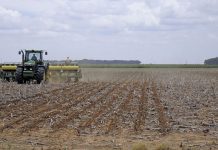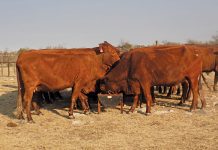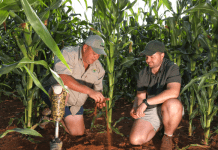In 2007 President Thabo Mbeki issued a directive to his top officials that they should devise high-impact projects jointly among different government departments and tiers, in efforts to work together to eradicate poverty, create jobs and speed up economic growth.
This is easier said than done. SA’s civil service is dominated by a silo mentality, with officials believing they are answerable only to their own managers rather than to the broader taxpayer and citizenry. Instead of working as partners to improve service delivery, officials do their best to undermine each others’ efforts. Rivalry, between departments, different levels of government and even different desks of the same section, is endemic. The results have been disastrous. For land reform to work, a seamless integration of support services from several spheres of government is required.
Responding to Mbeki’s directive, the agriculture and land affairs departments devised a joint implementation strategy for land reform, designed to draw together strands of the land programme housed in each department. Earlier this year the agriculture director general, Masiphula Mbongwa and his land affairs counterpart, Tozi Gwanya, signed off on a joint concept document, the Land and Agrarian Reform Project (LARP).
Key features
One of LARP’s key objectives is to redistribute 5 million hectares of white-owned farmland to blacks, mostly farmworkers, by 2014. Buying land in areas with large concentrations of farm dwellers and high eviction rates is thus a priority.
Several settlement models are envisaged. They include: creating agricultural villages with different portions of a farm set aside for housing; commercial farming; household food production and grazing; or settling farm dwellers on agricultural holdings around rural towns.
A key feature of the plan is for each province to define focus areas for implementation. These will be based on surveys already conducted on existing opportunities; agricultural comparative advantage in different regions; and the needs of target populations. Focus areas will include high-potential production areas along national roads and near major trade routes, high-value and demand commodities suited to particular regions and local municipalities experiencing high land-reform demand, including for restitution, labour tenant claims in crowded communal areas and informal settlements.
Guiding principles include making all private and public support services, including loans, grants, technical support and planning available at a single venue – a so-called one-stop shop – close to farming communities. Decision-making will also be devolved to the lowest level to ensure the right support services go to the right people and projects. Overall planning and management will be done jointly by national and provincial agriculture departments and parastatals, such as the Land Bank.
All projects will be aligned with support interventions from other departments such as housing, health or social services and will involve partnerships with private sector entities based on sound land-use choices supported by local economic and environmental considerations, following the so-called area-based planning model.
nother priority will be to revive agricultural production by 10% to 15% in former homelands, where valuable fertile land lies fallow.
Investments in livestock improvement will be stepped up, agricultural development corridors will be set up, degraded land and irrigation schemes will be rehabilitated, new schemes will be established and contract farming schemes set up for high-value feedstock such as biofuel, wine, essential oils, hemp, pharmaceuticals, leather, fruit and dairy products.
Crucially, a LARP enterprise should be able to absorb a combination of land claimants, labour tenants, farmworkers and people farming on crowded communal lands.
Poor track record
Given SA’s track record of trying to achieve its land reform aims, much of this looks like wishful thinking. For a start, land targets are hopelessly unrealistic. To redistribute 30% of white farms to blacks by 2014, 5 million hectares must be transferred in the nextwo years, according to Land Affairs. This is more than has been transferred in the last 14 years. From 2010, over 4 million hectares must be transferred every year to meet the target.
The document does however recognise that there were miscalculations in land costs. Land Affairs estimates a budget shortfall of R74 billion. “Given budgetary allocations for 2007/08 and 2008/09 and current land prices, these targets are not achievable,” the document says. Instead a scenario based on an annual budget increase of 6% and a land price hike of9,8% is presented as more likely to win Treasury’s support. The only snag is that it will take until 2025 to transfer 30%.
Similarly, several attempts have been made to foster cooperative governance in SA, with little effect. Moreover, inefficiencies and poor administrative skills in both lead departments – Agriculture and Land Affairs – are legendary. Efforts to date to revive agricultural production and irrigation schemes in the former homelands have been bedevilled by corruption, mismanagement and a lack of financial and entrepreneurial skills, markets and infrastructure.
Skills levels
The document does try to tackle these issues. Crucially, it places a high premium on beefing up skills levels across the board.
It points out that a recent audit showed that SA has only a third of the extension officers it needs, with 80% of these not adequately trained. Further it endorses the new extension recovery plan backed by Treasury, which has approved a R500 million allocation, over three years, to train another 5 000 officers. It wants a national agency for extension and advisory services to drive the process. The document calls for more investment into research to improve existing and new plant and stock varieties and a strengthening of agricultural colleges such as Grootfontein and Cedara. It also suggests establishing new schools, a network of biotechnology centres throughout the country and promoting mentorship networks with experienced commercial farmers.
It recognises that the lead departments don’t currently have the capacity to implement the plan. An additional annual operational budget of R2,1 billion is needed to rectify this. Major agribusinesses and co-ops will also be contracted to provide specialised technical, financial, marketing and land development services.
Other interventions outlined include beefing up existing and creating new agricultural infrastructure such as feeder roads, dams, dipping tanks and marketing depots; mobilising farm dwellers into agricultural co-ops and agribusinesses, and creating new cooperative financial services and marketing agencies.
Reforming land reform
A major overhaul of the administrative machinery of land reform is needed to put this plan into motion. The main innovations are based on the outcome of a review of two main key interventions – the Comprehensive Agricultural Support Programme (CASP) and the Land Redistribution for Agricultural Development programme (LRAD). Both were found to be in need of urgent improvement, including discouraging group farming in favour of individual executive management; devolving decision-making powers to districts and involving beneficiaries directly to minimise the dependence syndrome; embedding land reforms in local economic development plans; and integrating all supports in a unified grants and single approval process.
LARP aims to give effect to these insights in several ways. At national level, an intergovernmental committee on land and agriculture will oversee the process. Sub-committees chaired by senior national and provincial officials will give strategic direction in land reform, agribusiness development, agriculture support, reviving agricultural production and budgets.
Provincial land forums consisting of officials, farmers’ unions and community representatives will submit implementation plans for approval by agricultural MECs, including criteria for allocating all grants such as minimum debt/equity ratios, to ensure viability and a secured market.
Planning and implementation of individual LARP projects will be done by district and municipal committees, also consisting of farming and community representatives and government officials. Their role will include identifying beneficiaries, economic opportunities and land; lobbying for and approving disbursement of funds; negotiating, buying, sub-dividing and expropriating farms; appointing service providers to develop farm and agribusiness infrastructure; and ensuring ongoing technical, marketing and financial services support.
The risks
The new land plan undoubtedly boasts several improvements. Putting locals in the driving seat should eliminate irrational decisions typical of current support structures, such as contractors being paid to plough fields in the wrong season and wooden fencing being delivered to fire ravaged districts.
Because land use decisions will be made by those directly affected, the needs of the district should be better served. Unifying grants and approvals should speed up land delivery. A massive investment in skills and training, including in sound financial management, should improve profitability of new farms, and joint planning and implementation of all spheres of government should improve cooperation among rival officials.
But major pitfalls remain. SA’s bureaucracy is riddled with officials’ intent on guarding their domains for the sake of self-enrichment or dispensing patronage. Until now there has been little evidence of political will to dislodge them, which means they will remain a serious threat to any progressive reform, especially at the coalface of LARP implementation at municipal and district level.
Moreover, it’s at this level where expertise and mature judgment is most needed, but generally least in evidence. Stakeholders with different needs, priorities and backgrounds – be they farmers, officials, or labour tenants – will have to learn to pull together. On the other hand, the instinct of SA’s senior bureaucrats to control every aspect of programmes under their jurisdiction could easily trip up this programme in red tape.
Only time will tell whether LARP is destined to repeat the disastrous mistakes made in a decade of failed land reform experiments.








